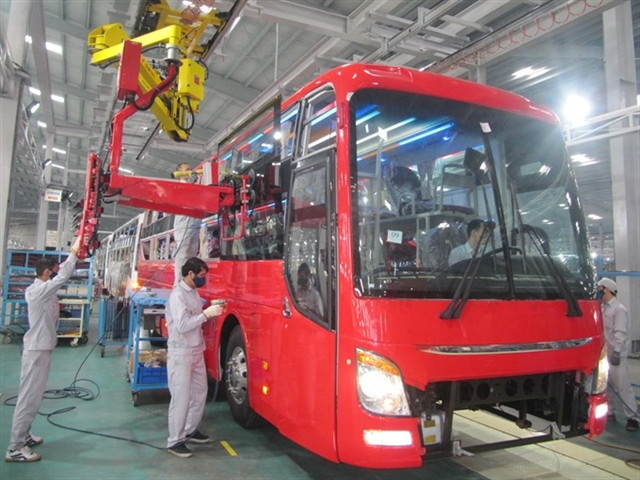 Workers at Truong Hai Automobile (Thaco) manufacture buses at its plant in the Chu Lai-Truong Hai Industrial Complex in Quang Nam province (Photo: VNA)
Workers at Truong Hai Automobile (Thaco) manufacture buses at its plant in the Chu Lai-Truong Hai Industrial Complex in Quang Nam province (Photo: VNA)Hanoi (VNS/VNA) - Vietnam’s automobile industry is smallcompared to regional markets and local suppliers are asking for more supportfrom the Government.
A report from the Ministry ofIndustry and Trade (MoIT) says though the rate of domesticallymanufactured and assembled vehicles have grown, only a few suppliers areinvolved in the local supply chain. Compared to Thailand, the number ofVietnamese suppliers in the automotive industry is low.
The report saysThailand has nearly 700 Tier 1 suppliers, which supply parts or systemsdirectly to original equipment manufacturers, while Vietnam has less than 100. Thailand hasabout 1,700 Tier 2&3 suppliers, which provide raw, or close-to-raw,materials like metals and plastics for the Tier 1 category, while Vietnam has less than 150. Locallymanufactured 9-seater cars in Vietnam only meet 7-10 percent of the demand.
Pham Tuan Anh, deputy director of the departmentof industry, told the VietnamNews Agency at a recent seminarthat market capacity was small because the local automobile industry did nothave the conditions to grow.
Anh specified: “Vietnam does not offer enough support forthe automobile industry.”
He also said policiesthat supported the automotive industry still conflicted and were unstable.
Do Thu Hoang, Deputy General Director of Toyota Vietnam, also said that following ASEAN integration in 2018, the import tax on completecars was cut to zero percent within the bloc, and that had created moredifficulties for the industry.
Hoang said the biggest challenge wasthe small size and output of the market. For example, the number of Toyota’sVios model cars produced in Vietnam was only one-eighth of Thailand's, which made production costshigher than other countries in the region.
Due to limitedproduction, most manufacturers had to import parts, which resulted in very highcosts for packaging, shipping and import duties.
Hoang continued: “Currently, the costof manufacturing in Vietnam is 10-20 percent higher than in Thailand and Indonesia.”
“Before 2018, whenthere were high taxes for imported cars, locally produced cars were still ableto compete. Now the rate has been cut to zero percent, it is very difficult forcar manufacturers in Vietnam,” she said.
Compared withThailand and Indonesia, Vietnam’s automobile output is far behind. Thailand produces about 2 millioncars and Indonesia 1.3 million cars each year, while Vietnam can only produce about 300,000.
A representative ofthe Vietnam Automobile Manufacturers Association (VAMA) told the seminar thatlocal car manufacturers planned to make 500,000 cars next year.
To cope with thesedifficulties, local manufacturers at the seminar asked for more supportpolicies from the State.
Pham Van Tai, General Director of Thaco Truong Hai,said: “Vietnam needs certain technical barriers to help local carmakers. For example, in order to enjoy the zero percent import tax rate,imported cars must have a localisation rate of 40 percent."
He also said the Government should lower the specialconsumption tax on the value of domestic production in order to reduce the priceof locally manufactured cars.
Another representative from the MoIT’s industrydepartment suggested the Government offer incentives for consumers who purchaselocally-made products to increase demand. The same thing had been done inThailand and Malaysia, he said.
At the seminar, some manufacturers asked the Ministryof Finance to remove the special consumption tax for locally made parts to helpthem reduce prices to compete with foreign manufacturers./.





























